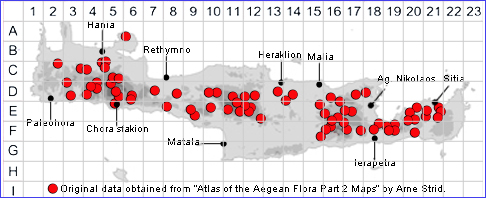
CREPIS FRAASII subsp. FRAASII
Includining:- Subsp. mungieri found mostly at medium and high altitude on
Crete and Karpathos, is generally smaller and more glandular-pubescent than
subsp. fraasii, but there are many intermediates and the taxonomic status of the
former is doubtful. 1)
1) Arne Strid "Atlas of the Aegean Flora". Book 1 2016
Family:- COMPOSITAE/Sect. HIERACIOIDES
Common Names:- None
Synonyms:- None
Meaning:- Crepis (Gr) A name used by Greek philosopher Theophrastus.
Fraasii (L) Named after Carl Fraas, author of Synopsis Plantarum
Florae Classicae (1845).
General description:- Perennials.
Stems:-
1) 6-35 cm.
Leaves:-
1) With glandular or eglandular hairs.
2) Basal, 3-22 x 0·8-5·2 cm, oblanceolate, lyrate-pinnatifid the terminal segment
broadly ovate and remotely denticulate, the lateral segments broad, obtuse,
close or remote.
3) Lower cauline, like the basal or lanceolate and dentate.
4) Upper cauline, bract-like.
Flowers:-
1) Capitula few to many in a compound or irregular corymb.
2) Involucre 9-10 x 4-5 mm.
3) Bracts linear-lanceolate, acute, the outer ¼ - ½ as long as the inner, with
numerous, short glandular and sometimes some longer eglandular hairs.
Fruit:-
1) Achenes 3-5 mm, dark brown, fusiform, more or less curved, 15- to 20-ribbed.
Key features:-
1) Achenes 15- to 20-ribbed.
2) Leaves lyrate-pinnatifid with broad, obtuse lateral segments and a broadly
obovate terminal segment.
3) Involucre with dense, short, glandular and sometimes eglandular hairs.
4) Cauline leaves few and, except the lowermost, bract-like, not amplexicaul.
Habitat:- Calcareous cliffs, crevices, ledges & rocky slopes from 0-2300 m.
Distribution:- Greece and south-western Asia. Widespread on Crete, but
commoner in the higher mountains.
Flowering time:- Apr-Aug.
Photos by:- Fotis Samaritakis
SPECIES DESCRIPTION
